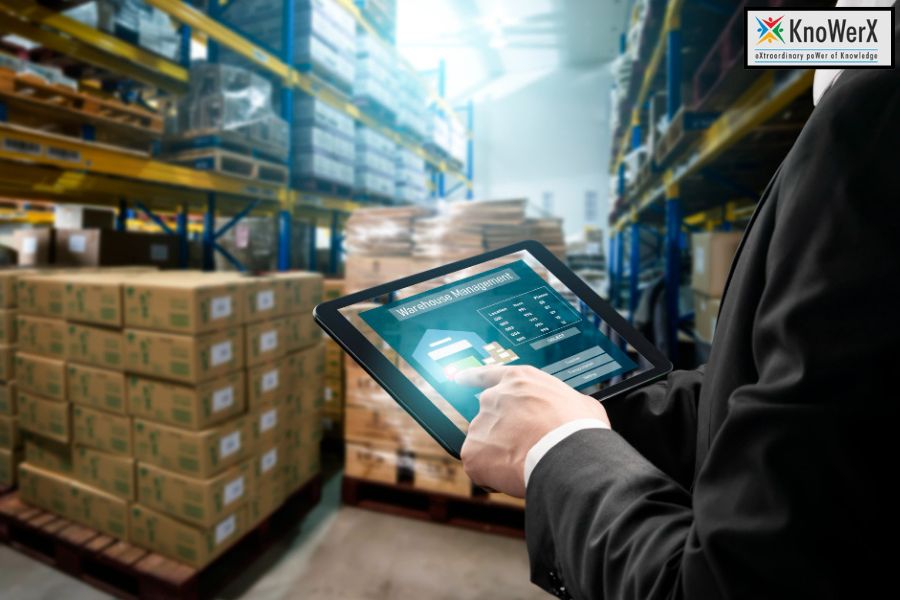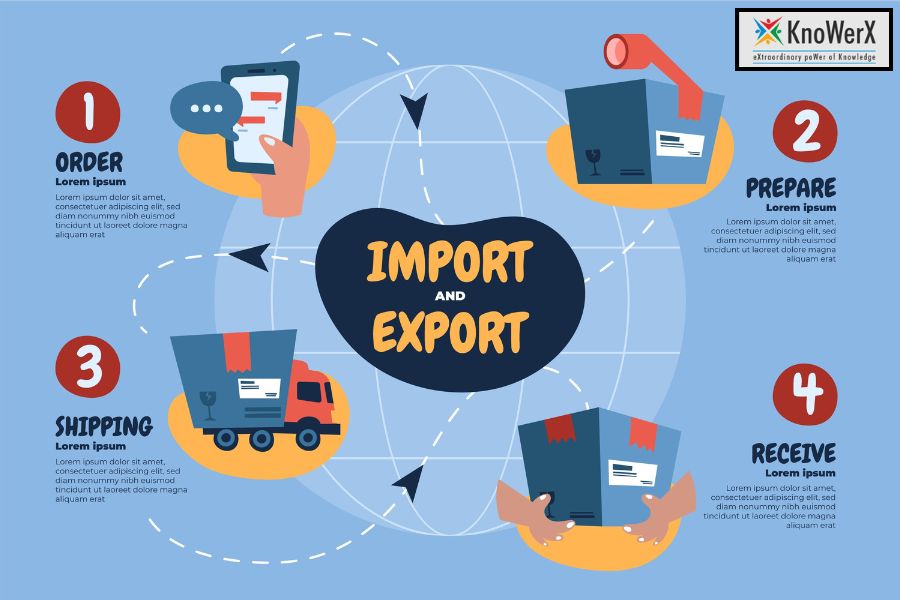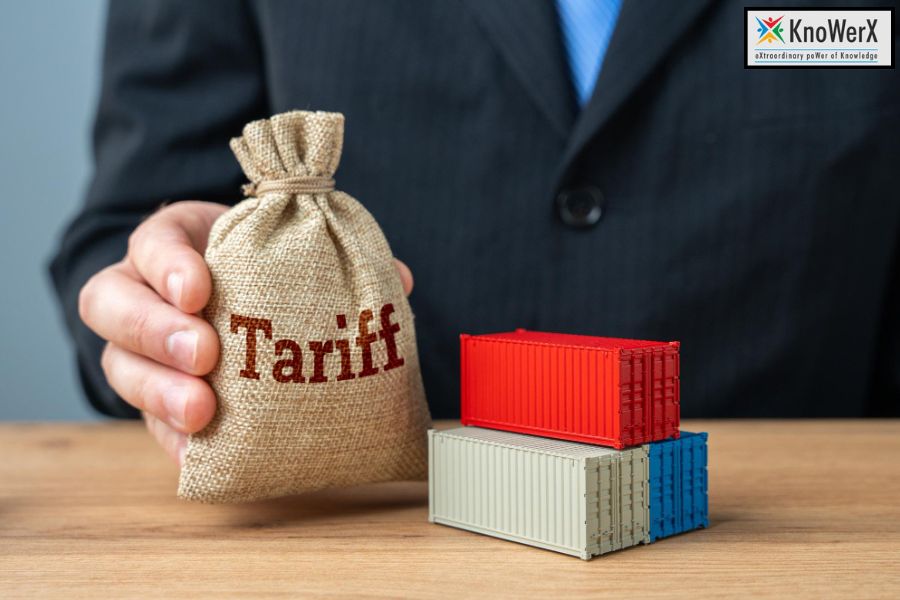Proven Supply Chain Maturity Assessment Strategies

Proven Supply Chain Maturity Assessment Strategies At KnoWerX, we believe that achieving excellence in Supply Chain Management requires more than operational proficiency it demands Supply Chain Maturity. With over 33 years of collective experience in the education and consultancy field, our team has guided countless organizations in India and abroad to elevate their performance through structured assessments and training. In this article, we share key tips for understanding and applying Maturity Assessment Models in Supply Chain, helping you move from evaluation to actionable results. 1. What Exactly is Supply Chain Maturity? Before diving into the assessment, let’s start with a simple idea: Supply Chain Maturity represents how efficient, agile, and strategically aligned your organization’s supply chain is. A mature supply chain integrates people, processes, and technology seamlessly to maximize value across the network. Tip: Start by mapping your supply chain processes against organizational goals. This helps identify whether the supply chain functions merely as a cost center or as a strategic growth enabler. Understanding this positioning lays the groundwork for using Maturity Assessment Models in Supply Chain effectively. A highly mature supply chain isn’t built overnight; it evolves through stages from initial functional efficiency to an integrated, adaptive, and data-driven ecosystem. Knowing where you stand in this journey is the first crucial step. 2. The Power of the Assessment: Why Maturity Matters A well-structured Maturity Assessment acts like a diagnostic tool it identifies strengths, inefficiencies, and untapped opportunities. In fast-evolving global markets, companies that regularly perform Maturity Assessment Models in Supply Chain gain clearer insights into their operational resilience and business continuity capabilities. Tip: Make your assessment recurring, not one-time. The most successful organizations conduct Maturity Assessments annually or bi-annually to track improvements, benchmark progress, and ensure alignment with changing business strategies. This will help your supply chain stay responsive rather than reactive. Another important point is that maturity directly impacts competitiveness. High maturity leads to better decision-making through advanced analytics, improved supplier collaboration, and flexible resource utilization — all of which translate to superior customer service and profitability. 3. The Key Models Shaping the Industry Several Maturity Assessment Models in Supply Chain are currently guiding industry leaders across the globe. Understanding these frameworks can help organizations choose one that best fits their goals. Tip: Don’t just adopt a model—adapt it to your context. Each organization’s challenges and priorities differ. Here are some of the most influential models: SCOR (Supply Chain Operations Reference) Model: This globally recognized framework provides metrics, process elements, and best practices to measure operational performance. It benchmarks businesses on their Plan, Source, Make, Deliver, and Return processes. Gartner’s Five-Stage Model: This model evaluates maturity from reactive (low maturity) to anticipatory (high maturity) based on integration, analytics, and adaptability. APICS Supply Chain Maturity Model: Developed by professionals like those at KnoWerX, this model offers a structured roadmap to evaluate performance capabilities and align organizational objectives. Digital Maturity Frameworks: As supply chains increasingly digitize, these frameworks assess technological integration, automation levels, and data intelligence maturity. When choosing Maturity Assessment Models in Supply Chain, focus on models that emphasize technological readiness, cross-functional integration, and continuous improvement metrics. 4. Your Next Step: From Assessment to Action The true value of a Maturity Assessment lies not in the report produced, but in the actions that follow. Once you identify your supply chain’s maturity level, build a roadmap for improvement that includes specific timelines, measurable objectives, and cross-functional responsibilities. Tip: Prioritize initiatives that deliver quick wins to gain organizational buy-in. For example, automate repetitive processes before delving into predictive analytics. Small, visible results create momentum toward achieving higher maturity levels. Furthermore, partner with experienced professionals and educators like our team at KnoWerX to interpret your assessment results effectively. We not only guide you in analyzing the assessment but also provide training and certification programs that empower your workforce to reach the next stage of maturity. 5. Why KnoWerX Is Your Strategic Partner For over two and a half decades, KnoWerX Education (India) Pvt. Ltd. has been a beacon for professionals seeking growth in Supply Chain Management. We are dedicated to equipping teams and individuals with world-class knowledge and tools to transform their operations. Tip: Invest in education before modernization. Upskilling your workforce ensures your maturity roadmap is sustained by capable leaders who can implement evolving Maturity Assessment Models in Supply Chain with confidence. With a team boasting decades of experience in training and consulting, we ensure that your organization transitions smoothly from assessment to execution, leveraging best-in-class maturity practices Frequently Asked Questions Ending Notes Achieving supply chain maturity isn’t a one-time effort it’s a continuous journey of self-evaluation, learning, and improvement. The right Maturity Assessment Models in Supply Chain act as a compass that helps organizations navigate complexities, innovate responsibly, and stay agile in competitive markets. At KnoWerX, our mission is to empower professionals toward operational excellence. Whether you’re just starting your assessment journey or striving for global standards, partnering with us ensures that your growth is structured, measurable, and sustainable. Your next move? Start your Supply Chain Maturity Assessment today and set your organization on the path to long-term success. Image Reference: Freepik Disclaimer: All trademarks, logos, and brand names are the property of their respective owners. All company, product, and service names used in this website are for identification purposes only. Use of these names, trademarks, and brands does not imply endorsement.
The Ultimate Online Supply Chain Procurement Certificate Guide

The Ultimate Online Supply Chain Procurement Certificate Guide In today’s fast-paced global economy, the efficiency of supply chains can make or break a business. At the heart of this efficiency lies procurement, a vital function responsible for acquiring the right goods and services at the right time, cost, and quality. As businesses transform digitally and seek competitive advantages, the demand for skilled procurement professionals is soaring. One way to meet this demand and future-proof a career is by earning an Online Supply Chain Procurement Certificate. This certification empowers professionals with the knowledge and skills to excel in procurement and supply chain management roles while offering unmatched flexibility for learners across the globe. What Is an Online Supply Chain Procurement Certificate? An Online Supply Chain Procurement Certificate is a specialized credential designed to equip individuals with a comprehensive understanding of procurement processes within the supply chain. Unlike traditional degrees, this certification focuses directly on procurement strategies, supplier management, contract negotiation, and the use of data analytics in decision-making. Typically offered by accredited institutes, these programs cover essential topics such as strategic sourcing, supplier relationship management, risk assessment, and logistics fundamentals. The online format makes this certification accessible to working professionals, students, and career changers alike, as it allows for self-paced learning that fits around busy schedules. Many programs provide interactive modules, case studies, and assessments that simulate real-world scenarios, enabling learners to apply concepts effectively. Why Procurement Is a Career Powerhouse Procurement is no longer viewed as a transactional function focused solely on purchasing. It has evolved into a strategic business powerhouse that directly impacts a company’s profitability, sustainability, and competitive positioning. The modern procurement professional is a key player in supply chain optimization, cost control, innovation, and supplier collaboration. Globally, industries ranging from manufacturing and retail to healthcare and technology are actively seeking procurement experts who can manage complex supply chains and negotiate contracts that align with business goals. This demand translates into a wealth of career opportunities with attractive salary packages and upward mobility. Moreover, procurement careers offer a dynamic environment where professionals can develop problem-solving, analytical thinking, and leadership skills. Job roles such as Procurement Analyst, Strategic Sourcing Specialist, and Supply Chain Manager illustrate the diverse paths available, each commanding strategic importance within organizations. The Benefits of an Online Procurement Certificate Earning an Online Supply Chain Procurement Certificate offers many advantages that make it a smart career investment: Flexibility: The online delivery model allows learners to study from anywhere at any time, balancing education with work and personal commitments. This flexibility is especially important in today’s global economy where professionals seek continuous upskilling without career interruptions. Career Advancement: Certification serves as a powerful credential that validates expertise and can differentiate candidates in competitive job markets. Certified professionals are often considered for leadership and managerial roles due to their demonstrated commitment and knowledge. Skill Enhancement: The certificate program develops critical skills in cost analysis, supplier negotiation, contract management, risk reduction, and sustainable procurement practices. These capabilities enable professionals to contribute significantly to organizational goals. Global Recognition: Many online procurement certificates are recognized internationally by industry bodies and employers, increasing career mobility and opportunities abroad. Networking Opportunities: Online programs often provide access to global cohorts, expert instructors, and alumni networks, fostering connections that facilitate knowledge exchange and career growth. Cost-Effectiveness: Compared to traditional degrees, online procurement certificates are more affordable while still delivering specialized, industry-relevant education. Key Skills You Gain from Certification The knowledge gained through an Online Supply Chain Procurement Certificate equips professionals with essential skills that enhance their decision-making and operational efficiency: Strategic Sourcing and Supplier Negotiation: Learn to identify the best suppliers and negotiate contracts that balance cost, quality, and reliability. Contract Management and Risk Mitigation: Understand legal and ethical considerations while managing supplier relationships to mitigate risks. Supply Chain Analytics and Technology Integration: Utilize data-driven insights and digital tools to optimize procurement processes. Sustainable Procurement and Ethical Sourcing: Incorporate environmental and social responsibility into sourcing decisions, supporting corporate sustainability goals. Budget Optimization and Cost-Saving Strategies: Implement techniques to reduce expenses while maintaining product or service standards. These skills prepare professionals to handle complex procurement challenges effectively, making them invaluable assets to their organizations. How to Choose the Right Online Procurement Program Selecting the appropriate Online Supply Chain Procurement Certificate program requires careful consideration of several factors: Accreditation and Credibility: Ensure the program is offered by a recognized institution with industry endorsements. Course Content Relevance: The curriculum should cover contemporary procurement practices and tools relevant to the participant’s career goals. Duration, Cost, and Format: Look for programs that fit your time availability and budget, and that offer interactive materials and support. Mentorship and Placement Assistance: Programs providing career guidance and networking support can enhance post-certification opportunities. Success Stories and Employer Recognition: Research alumni outcomes and how employers value the certification for real-world validation. Making an informed choice leads to better learning outcomes and maximizes the certification’s value. Career Opportunities After Certification With an Online Supply Chain Procurement Certificate, graduates can pursue numerous roles across sectors actively recruiting procurement professionals. Common job titles include Procurement Specialist, Category Manager, Supplier Quality Manager, and Supply Chain Consultant. Salaries vary by experience and industry but generally reflect substantial growth potential due to the critical nature of procurement in business operations. Additionally, the shift towards digital procurement tools and sustainable supply chains is creating new demand for skilled professionals adept with technology and environmental practices. This evolving landscape provides a fertile ground for career advancement and specialization. Frequently Asked Questions Ending Notes: The KnoWerX Perspective From the vantage point of KnoWerX, a leading institute in supply chain management education, an Online Supply Chain Procurement Certificate represents a vital stepping stone for professionals aiming to thrive in procurement careers. KnoWerX emphasizes practical learning, industry-relevant curriculum, and global recognition, making its certification programs particularly powerful for career growth. Choosing KnoWerX’s online procurement certification means more than acquiring knowledge—it means joining a community committed to excellence and innovation in supply chain management. As procurement
Winning Organisational & Business Units Strategies 2025

Winning Organisational & Business Units Strategies 2025 In 2025, businesses face an unprecedented pace of change, driven by digital transformation, evolving supply chain dynamics, and increased global competition. To remain relevant and grow sustainably, leaders need clear and actionable Organisational and Business Units strategies 2025. At KnoWerX, with our 33+ years of collective expertise in Supply Chain Management training and consultancy, we help professionals and companies refine their strategic approach and achieve measurable success. Here are our top tips for designing and implementing powerful Organisational and Business Units strategies 2025 that will allow your company to thrive: Align Strategies With Vision and Mission Your organisation’s vision and mission should be the north star for all strategic decisions. Ensure every business unit’s goals are aligned with the company’s overarching purpose. Conduct strategic workshops to bridge the gap between leadership intent and operational execution. Prioritise initiatives that strengthen your core value proposition while adapting to emerging market needs. At KnoWerX, we train professionals to examine how organisational vision translates into actionable business unit plans, a critical step in ensuring Organisational and Business Units strategies 2025 are coherent and sustainable. Integrate Supply Chain Resilience Into Strategies The global supply chain landscape is highly vulnerable to disruptions. Build resilience by diversifying suppliers and creating contingency plans. Encourage cross-functional collaboration between procurement, logistics, and marketing teams. Embrace real-time data and analytics tools to make informed strategic adjustments. In our professional programs, we emphasize how Organisational and Business Units strategies 2025 must embed supply chain agility as a competitive advantage, not merely a risk management tool. Foster Agility and Adaptability Rapid technological advancements demand adaptable strategies. Implement agile planning models that allow for quarterly reviews and course corrections. Train teams to pivot quickly in response to economic or market shifts. Use scenario planning to prepare for multiple future states. KnoWerX believes that agility is no longer optional; the best Organisational and Business Units strategies 2025 will allow companies to reconfigure processes swiftly to seize emerging opportunities. Empower Decision-Making With Data-Driven Insights Data analytics is the backbone of smart strategic decisions. Invest in up-to-date business intelligence platforms to gather and analyze performance data. Use predictive analytics to forecast market trends and customer behavior. Encourage a data-driven culture where decisions are backed by quantifiable evidence. Our training programs equip professionals with advanced analytical tools, ensuring they can apply data rigorously in crafting Organisational and Business Units strategies 2025. Align KPIs Across Organisation and Units Consistency in tracking performance is key to strategic success. Define key performance indicators (KPIs) that align across business units. Maintain transparency so that every department understands its contribution to organisational objectives. Use a balanced scorecard approach to monitor progress holistically. KnoWerX helps leaders design KPI frameworks that bind Organisational and Business Units strategies 2025 together seamlessly, avoiding fragmented efforts. Build Talent Development Into the Strategy Strategies succeed only when people execute them effectively. Invest in continuous professional development and skills enhancement. Identify leadership pipelines within each business unit. Encourage cross-departmental training to foster innovation and collaboration. As India’s leading supply chain education provider, we ensure that talent development is a central pillar in Organisational and Business Units strategies 2025, enabling long-term value creation. Leverage Emerging Technologies Technology integration is not optional in 2025. Adopt automation, AI, and IoT solutions to improve efficiency and decision-making. Encourage digital literacy across all levels of the organisation. Experiment with innovative tools, but ensure they align with overall strategic objectives. Our expertise guides companies in blending technology with operational strategy without losing sight of organisational goals. Technology-driven Organisational and Business Units strategies 2025 deliver competitive advantage faster than traditional approaches. Monitor, Measure, and Refine Strategies Continuously Effective strategies require ongoing review and adaptation. Conduct strategy audits at least twice a year. Benchmark performance against industry leaders and adjust tactics accordingly. Maintain an environment of feedback where employees contribute ideas for improvement. The Organisational and Business Units strategies 2025 we promote at KnoWerX are designed to evolve, ensuring they remain relevant in dynamic market conditions. Frequently Asked Questions Ending Notes In 2025, winning organisations will be those that connect the big picture with precise, adaptable, and data-led unit-level strategies. Whether you are building resilience into your supply chain, fostering talent, or leveraging AI, the key to success lies in aligning every business unit to the overall strategic vision. KnoWerX is committed to guiding professionals and companies to design and implement Organisational and Business Units strategies 2025 that deliver measurable results and sustained growth. Image Reference: Freepik Disclaimer: All trademarks, logos, and brand names are the property of their respective owners. All company, product, and service names used in this website are for identification purposes only. Use of these names, trademarks, and brands does not imply endorsement.
Role of Operations Managers in SCM Uncovered

Role of Operations Managers in SCM Uncovered The fast-paced and interconnected business environment, the Role of Operations Managers in SCM (Supply Chain Management) has become more vital than ever. Organisations across industries depend on Operations Managers to streamline processes, optimise resources, and ensure that supply chain activities run seamlessly from end to end. Whether it is production, procurement, logistics, or distribution, Operations Managers are the driving force behind efficiency and profitability. Let’s uncover their responsibilities and explore practical tips on how they excel in shaping supply chains that deliver results. Key Responsibilities of Operations Managers in SCM Operations Managers wear many hats in the supply chain domain. Their responsibilities range from ensuring goods are produced and delivered on time to keeping costs under control. Tip: Focus on building cross-functional collaboration. They act as the link between suppliers, internal departments, and customers. Coordinating procurement schedules, managing production timelines, and overseeing distribution networks require strong communication skills. An Operations Manager must make sure that all stakeholders are aligned with the organisation’s objectives. The Role of Operations Managers in SCM is not just about execution; it’s about balancing efficiency with adaptability. They need to anticipate changes in demand, adjust inventory strategies, and ensure that customer expectations are met without compromising quality. Strategic Planning & Process Optimisations Every supply chain thrives on planning. Poor planning leads to delays, excess costs, and dissatisfied customers. Tip: Design processes that adapt to uncertainty. Operations Managers must create strategies that not only meet current business needs but also remain flexible enough to adjust to unexpected challenges. For instance, optimising production lines, reducing bottlenecks, or improving logistics routes are all part of their daily responsibilities. The Role of Operations Managers in SCM extends to ensuring sustainable growth by reducing waste, enhancing productivity, and introducing innovative methods for continuous improvement. With a focus on long-term strategy, they help organisations remain competitive in volatile markets. Technology and Digital Transformation in Operations Modern supply chains are no longer paper-based or limited to manual decision-making. The digital revolution has reshaped how Operations Managers work. Tip: Adopt digital solutions to improve visibility and control. ERP systems, AI-powered forecasting, blockchain, and IoT devices are now essential tools in SCM. By embracing these technologies, Operations Managers can track shipments in real-time, analyse consumer demand with accuracy, and automate routine tasks to free up resources. The Role of Operations Managers in SCM today requires them to be digitally savvy. A strong command over data analytics and technology ensures that operations are not only efficient but also agile and future-ready. Risk Management in SCM Uncertainty is the only constant in global supply chains. From raw material shortages to sudden disruptions in transport, risks are unavoidable. Tip: Always prepare contingency plans. Operations Managers must conduct risk assessments to identify potential disruptions and develop mitigation strategies. For example, diversifying supplier bases, maintaining safety stock, or planning alternate logistics routes can safeguard against supply chain breakdowns. The Role of Operations Managers in SCM is crucial for building resilience. Their foresight and proactive planning prevent costly delays and ensure customer satisfaction even in challenging times. KPIs and Performance Measurement Performance that cannot be measured cannot be improved. Tracking metrics is key to operational excellence. Tip: Set measurable KPIs to drive results. Operations Managers use KPIs such as on-time delivery, order accuracy, inventory turnover, and cost per unit shipped to measure effectiveness. By analysing these indicators, they can identify strengths and areas of improvement within the supply chain. The Role of Operations Managers in SCM is incomplete without continuous monitoring. Regular performance reviews help businesses refine their strategies and achieve higher efficiency levels. Career Path and Skills Required for Operations Managers in SCM Operations Management is a career that blends technical know-how with leadership abilities. Tip: Invest in continuous learning and certifications. To succeed, Operations Managers must develop strong analytical skills, problem-solving abilities, and leadership qualities. A good understanding of supply chain software, global trade regulations, and financial management adds further value. ⭐⭐⭐⭐⭐ Client Review “Team provide excellent support. Easily reachable through whatsapp and call. Recently completed my CSCP certification through knowerx” The Role of Operations Managers in SCM opens diverse career opportunities, from plant management to global supply chain leadership roles. Professionals aiming for long-term growth should seek specialised training and certifications to stand out in competitive markets. Frequently Asked Questions Ending Notes KnoWerX – Your Trusted Partner in Supply Chain Success At KnoWerX, we recognise the significance of the Role of Operations Managers in SCM and their impact on global business success. We are an industry leader in Supply Chain Management Training, offering world-class education and professional certification programmes tailored to industry needs. With over 32 years of collective experience and more than 25 years in education and consultancy, the people behind KnoWerX have trained, guided, and consulted for leading companies in India and abroad. Our expertise lies in equipping professionals with practical skills in strategic planning, risk management, technology adoption, and performance measurement. Image Reference: Freepik Disclaimer: All trademarks, logos, and brand names are the property of their respective owners. All company, product, and service names used in this website are for identification purposes only. Use of these names, trademarks, and brands does not imply endorsement.
Easy Steps to Manage Internal Operations and Inventory

Easy Steps to Manage Internal Operations and Inventory Managing internal operations and inventory effectively is one of the most crucial responsibilities for any organization. Inefficient practices can lead to higher costs, stockouts, excess inventory, and dissatisfied customers. On the other hand, streamlined processes ensure smooth functioning, cost savings, and long-term growth. At KnoWerX, we believe that success in supply chain management comes from a balanced mix of standardized practices, modern technology, and skilled professionals. With over 33 years of combined experience in consultancy and training, we help organizations and individuals master the art of managing internal operations and inventory with ease. Below are some easy steps and practical tips that can transform how your organization manages resources, operations, and inventory. Standardize Processes Consistency is key in managing internal operations and inventory. When processes are standardized, employees know exactly what steps to follow, reducing errors and confusion. Create detailed Standard Operating Procedures (SOPs) for inventory handling, storage, order fulfillment, and returns. This ensures smooth operations and better accountability across teams. Use Technology & Automation Manual processes can slow down operations and increase chances of error. Leveraging technology such as ERP systems, inventory management software, and automation tools can drastically improve efficiency. For example, barcode scanning, RFID tags, and automated order processing can save time and provide real-time visibility into internal operations and inventory. Track Inventory Accurately Accurate inventory records are the backbone of effective management. Regular audits, cycle counting, and digital tracking ensure you always know what stock is available and where it is located. Businesses that prioritize accuracy in internal operations and inventory management avoid both overstocking and stockouts, ultimately improving profitability. Classify Inventory (ABC Analysis) Not all inventory holds the same value. Applying the ABC Analysis helps in classifying items based on importance: A-items: High-value items with lower sales frequency B-items: Moderate value and demand C-items: Low-value but high-frequency items This classification allows businesses to prioritize resources and focus on what matters most in their internal operations and inventory strategy. Forecast Demand Effectively Accurate demand forecasting is vital to avoid excess or insufficient inventory. Use historical sales data, seasonal trends, and advanced forecasting tools to predict demand patterns. This practice allows businesses to align internal operations and inventory with actual market needs, reducing waste and increasing customer satisfaction. Optimize Warehouse Layout A well-organized warehouse ensures quick access to inventory, reduced handling time, and lower operational costs. Group items logically, label storage areas clearly, and implement efficient shelving systems. Optimizing warehouse layouts enhances the overall performance of internal operations and inventory while improving employee productivity. Monitor KPIs Regularly Key Performance Indicators (KPIs) are essential to measure the effectiveness of your strategies. Monitor metrics such as order accuracy, inventory turnover ratio, carrying cost, and stockout rate. By consistently tracking these KPIs, businesses can identify gaps in internal operations and inventory management and make timely improvements. Train Employees Employees play a pivotal role in executing strategies. Regular training on handling procedures, safety measures, and technology use ensures that your workforce is equipped to maintain operational efficiency. At KnoWerX, we emphasize professional growth through education, enabling employees to manage internal operations and inventory with confidence and competence. Build Strong Supplier Relationships Suppliers directly impact the flow of inventory. Building strong, transparent, and reliable supplier relationships ensures timely deliveries, better negotiation opportunities, and greater flexibility during demand fluctuations. Robust partnerships support seamless internal operations and inventory management, particularly in volatile markets. Frequently Asked Questions Ending Notes Effective management of internal operations and inventory is not just about cost control it is about creating a foundation for sustainable growth. From process standardization to leveraging automation, accurate tracking, and employee training, every step contributes to building a more resilient supply chain. At KnoWerX, we go beyond theory. Through our professional training programs and globally recognized certifications, we empower professionals to adopt best practices in supply chain management. With decades of experience in training and consultancy, we are committed to helping individuals and organizations optimize their internal operations and inventory strategies for long-term success. If you are looking to enhance your knowledge and skills, KnoWerX is your one-stop destination to learn, grow, and thrive in the ever-evolving world of supply chain management. Image Reference: Freepik Disclaimer: All trademarks, logos, and brand names are the property of their respective owners. All company, product, and service names used in this website are for identification purposes only. Use of these names, trademarks, and brands does not imply endorsement.
Advance Skills with Online Supply Chain Management Course

Advance Skills with Online Supply Chain Management Course The supply chain industry is evolving at lightning speed. Businesses today need professionals who can adapt, innovate, and deliver efficiency across global networks. Gaining advanced skills is no longer an option; it’s a necessity. An Online Supply Chain Management Course is one of the smartest ways to upgrade your expertise and remain competitive in this dynamic sector. Below are key tips that highlight why advanced skills matter, what you gain, and how to choose the right course for your career growth. Understand Why Supply Chain Skills Need Advancement Global markets are shifting constantly due to technology, digitalization, and unexpected disruptions like pandemics or geopolitical issues. Traditional supply chain methods are not sufficient to handle today’s complexity. Advancing your skills ensures you can: Leverage technology such as AI, IoT, and automation. Handle risks with better forecasting and resilience strategies. Improve efficiency by mastering lean and agile supply chain practices. 👉 KnoWerX emphasizes that continuous learning through an Online Supply Chain Management Course prepares professionals to stay relevant in this competitive industry. Focus on Core Skills Gained Through Online SCM Courses An effective Online Supply Chain Management Course should equip you with both technical and managerial skills. Some of the core areas you’ll master include: Strategic Sourcing & Procurement – Learn how to optimize supplier relationships and negotiate effectively. Demand Planning & Forecasting – Understand how to predict customer needs and balance supply. Inventory & Warehouse Management – Gain expertise in maintaining the right stock levels with minimal costs. Logistics & Transportation – Acquire knowledge on managing multi-modal transportation for speed and cost efficiency. Analytics & Technology Tools – Use data analytics and ERP systems to drive informed decisions. 👉 These skills directly translate into higher employability and leadership opportunities. Take Advantage of Online Learning Online learning has transformed professional education by making it accessible, flexible, and affordable. With an Online Supply Chain Management Course, you can: Learn at your own pace without disrupting your work schedule. Access global trainers and industry experts with decades of experience. Join interactive sessions that simulate real-world business scenarios. Save costs on commuting or relocating for training programs. 👉 At KnoWerX, we design courses to blend theory with practical insights, ensuring professionals can apply knowledge directly at work. Know Who Should Enrol An Online Supply Chain Management Course is beneficial for a wide range of professionals, including: Fresh Graduates – looking to enter the industry with strong foundational skills. Working Professionals – aiming to move into managerial or leadership roles. Entrepreneurs & Business Owners – who want to streamline operations and reduce costs. Industry Specialists – seeking globally recognized certifications to validate expertise. 👉 Whether you are starting your career or looking to upgrade, KnoWerX courses are tailored to suit all professional levels. Look at the Career Benefits of Advanced SCM Skills Enhancing your skills through an Online Supply Chain Management Course unlocks significant career opportunities. Some key benefits include: Higher Salaries – Skilled SCM professionals are in demand globally. Career Growth – Move from operational roles to leadership positions. Global Opportunities – Work with multinational corporations and across diverse industries. Future-Readiness – Stay prepared for technological and market disruptions. 👉 KnoWerX-trained professionals have successfully transitioned into impactful roles in India and abroad. Choose the Right Online SCM Course Not all courses are created equal. Here are a few things to consider when choosing the right Online Supply Chain Management Course: Accreditation & Recognition – Ensure the course is industry-approved. Experienced Trainers – Look for trainers with practical industry expertise. Practical Learning Modules – Case studies, simulations, and real-world applications. Flexible Learning Options – Courses that fit your schedule and career stage. Cost vs. Value – Select programs that provide maximum ROI on your investment. 👉 With over 33 years of combined expertise, KnoWerX has designed courses that tick all these boxes, making us a trusted partner for your professional growth. Frequently Asked Questions Ending Notes: Grow with KnoWerX Advancing your supply chain skills is essential in today’s global business environment. An Online Supply Chain Management Course not only equips you with in-demand knowledge but also boosts your career prospects significantly. At KnoWerX, we bring 26+ years of experience in training and consulting, backed by a strong record of helping professionals and organizations excel. Our mission is to provide the best quality education at the most competitive price, ensuring that you gain the expertise needed to lead the future of supply chains. 👉 If you are ready to enhance your career and stay ahead in this competitive industry, KnoWerX is your one-stop destination for supply chain excellence. Image Reference: Freepik Disclaimer: All trademarks, logos, and brand names are the property of their respective owners. All company, product, and service names used in this website are for identification purposes only. Use of these names, trademarks, and brands does not imply endorsement.
Top Benefits of Acquiring CSCP Online Certification

Top Benefits of Acquiring CSCP Online Certification The CSCP Online Certification (Certified Supply Chain Professional) is one of the most prestigious credentials for supply chain professionals worldwide. It is designed to provide a deep understanding of end-to-end supply chain operations, covering everything from suppliers to customers. By acquiring this certification, professionals demonstrate their ability to apply global best practices, handle complex challenges, and drive measurable business results. At KnoWerX, we believe that the CSCP Online Certification is more than just a qualification—it’s a pathway to career advancement, global recognition, and professional growth. With over 33 years of combined expertise in consultancy and training, our team is dedicated to guiding learners toward success with structured programs and expert mentorship. At KnoWerX, we specialize in guiding professionals through their certification journey, equipping them with practical knowledge, strategic thinking, and tools to excel. Let’s explore the top benefits of acquiring CSCP Online Certification: 1. Global Recognition The CSCP Online Certification is recognized across industries worldwide, making it a true international credential. Whether you want to grow in India, move abroad, or work with global supply chains, this certification strengthens your professional credibility. It demonstrates that you are aligned with world-class supply chain standards and practices. 2. Comprehensive Supply Chain Knowledge Unlike basic courses, the CSCP Online Certification covers end-to-end supply chain concepts, from suppliers and production to logistics and customers. It enhances your understanding of best practices, emerging technologies, and demand forecasting techniques. This knowledge allows you to make smarter decisions and add measurable value to your organization. 3. Career Advancement & Higher Salaries Certified professionals with CSCP Online Certification often enjoy faster promotions and higher pay scales. Employers see this credential as proof of advanced skills and leadership potential. By investing in this certification, you position yourself as a high-value professional, opening doors to new job roles and greater financial rewards. 4. Enhanced Problem-Solving Skills The certification emphasizes real-world problem-solving and strategic thinking. With the CSCP Online Certification, you learn to identify gaps in processes, reduce inefficiencies, and improve supply chain resilience. This ability to solve challenges proactively makes you a go-to expert in your organization. 5. Networking Opportunities Through the CSCP Online Certification, you join a global community of supply chain professionals. This network provides access to insights, industry trends, and career opportunities. Interacting with peers and experts opens doors to collaborations and lifelong professional relationships that strengthen your career path. 6. Online Learning Flexibility One of the biggest advantages of the CSCP Online Certification is the flexibility of learning. With KnoWerX, you can balance your professional life while studying at your own pace. The online modules ensure that busy professionals do not have to compromise their work schedules while preparing for global success. 7. Who Should Pursue CSCP? The CSCP Online Certification is perfect for supply chain managers, consultants, analysts, operations managers, logistics professionals, and aspiring leaders. If you’re aiming to upgrade your skills, gain recognition, and achieve rapid career growth, this certification is designed for you at KnoWerx. Frequently Asked Questions Why Choose KnoWerX? At KnoWerX, we bring over 33 years of combined experience in education and consultancy. With 26+ years in professional training experience, we have helped individuals and organizations transform their supply chain practices. We are committed to providing the best quality education, empowering you to grow, excel, and lead with confidence. Image Reference: Freepik Disclaimer: All trademarks, logos, and brand names are the property of their respective owners. All company, product, and service names used in this website are for identification purposes only. Use of these names, trademarks, and brands does not imply endorsement.
Online CPIM 8.0 Certification for Supply Chain Pros

Online CPIM 8.0 Certification for Supply Chain Pros The world of supply chain management is evolving at lightning speed. To keep up with new technologies, global disruptions, and shifting customer expectations, professionals need more than just hands-on experience they need recognized knowledge, structured learning, and globally validated credentials. One of the best ways to achieve this is through Online CPIM 8.0 Certification for Supply Chain Pros, a program designed by APICS (now ASCM) to empower supply chain professionals with advanced knowledge and practical insights. At KnoWerX, we believe in enabling professionals to thrive through industry-leading certifications. With over three decades of experience in training and consultancy, we have guided thousands of supply chain aspirants in their career growth. Here are some valuable tips for professionals considering the Online CPIM 8.0 Certification and how you can maximize its impact. Understand Why Supply Chain Professionals Need CPIM A supply chain today is not just about moving goods it is about balancing efficiency, responsiveness, and resilience. Here’s why earning CPIM matters: Build Expertise Across the Value Chain: CPIM covers demand planning, procurement, production, inventory, and distribution, ensuring you understand every step of the chain. Gain Global Recognition: Employers worldwide recognize CPIM as a benchmark of supply chain knowledge. Stay Competitive: In an increasingly crowded job market, CPIM certification sets you apart with validated skills. Tip: Before starting your CPIM journey, reflect on your career goals. Are you aiming for a promotion, transitioning roles, or improving your technical expertise? This clarity will help you stay motivated throughout your training. Familiarize Yourself with the Key Updates in CPIM 8.0 The new version, CPIM 8.0, has been designed to align with current industry realities. Some updates include: Streamlined Learning Modules: Content is more focused, making it easier to grasp core concepts without overwhelming redundancy. Integration of Modern Practices: Coverage includes supply chain resilience, sustainability, and digitization. Enhanced Exam Structure: The 8.0 exam format is designed to test both practical and conceptual knowledge efficiently. Tip: Dedicate time early on to understand the structure of CPIM 8.0 so you can tailor your study schedule accordingly. KnoWerX provides structured guidance and updated study materials to help you focus on what matters most. Leverage the Benefits of Online CPIM Training Online learning has become the new normal, offering flexibility without compromising quality. With KnoWerX, online CPIM training brings you several advantages: Learn Anytime, Anywhere: Busy professionals can fit training into their schedules. Interactive Online Sessions: Our instructors use case studies, simulations, and live discussions to replicate a classroom experience. Access to Study Resources: Participants get updated materials, practice tests, and support for exam readiness. Tip: Treat online training as seriously as an in-person course. Block your calendar, participate actively, and use online forums for peer interaction. Recognize the Career Impact of CPIM Certification Earning your CPIM credential can be a turning point in your professional journey. Here’s how: Better Job Prospects: CPIM-certified professionals are in high demand across industries like manufacturing, logistics, and consulting. Salary Growth: According to global surveys, CPIM-certified professionals earn significantly more than their non-certified peers. Leadership Roles: The certification equips you with the strategic thinking required for senior supply chain roles. Tip: Highlight your Online CPIM 8.0 Certification on your resume and LinkedIn profile as soon as you complete it. Employers often use certification filters when shortlisting candidates. Stay Updated with Upcoming Online CPIM Training with KnoWerX KnoWerX has consistently delivered high-quality supply chain education and is a trusted partner for APICS certifications. Our upcoming Online CPIM 8.0 Certification programs are designed to provide: Guidance from Industry Experts: Trainers with decades of experience in supply chain management. Practical Application: Real-world examples and case studies that connect theory to practice. Support Until Success: From training to exam preparation, we ensure you are never alone in your learning journey. Tip: Register early for upcoming batches. Early registration not only secures your seat but also gives you access to pre-course materials that can help you start strong. Frequently Asked Questions Ending Notes The Online CPIM 8.0 Certification for Supply Chain Pros is not just another credential it is a career-defining opportunity. By understanding why it matters, staying updated on changes, leveraging online learning benefits, and tapping into KnoWerX’s expertise, you can transform your professional future. At KnoWerX, we are committed to empowering supply chain professionals with the knowledge and tools to succeed. Whether you are aiming for a promotion, expanding your expertise, or exploring global opportunities, CPIM 8.0 can be your gateway to success. Are you ready to take your career to the next level? Join the upcoming CPIM 8.0 training sessions with KnoWerX and step confidently into the future of supply chain management. Image Reference: Freepik Disclaimer: All trademarks, logos, and brand names are the property of their respective owners. All company, product, and service names used in this website are for identification purposes only. Use of these names, trademarks, and brands does not imply endorsement.
How to Manage Tariff Impact on Global Sourcing Smartly

How to Manage Tariff Impact on Global Sourcing Smartly In today’s interconnected economy, global sourcing has become an essential part of supply chains. Companies rely on international suppliers for raw materials, components, and finished goods to reduce costs and expand market reach. However, shifting trade dynamics and government-imposed tariffs are reshaping global commerce. The Tariff Impact on Global Sourcing is one of the biggest challenges supply chain professionals face, as it directly affects pricing, supplier selection, and competitiveness. Managing tariffs smartly requires strategic thinking, adoption of technology, and a balance between cost efficiency and resilience. This article explores effective strategies, the role of analytics, and practical ways businesses can navigate tariff challenges. Understanding Tariff Impact on Global Sourcing What Exactly Are Tariffs? Tariffs are taxes imposed on imported goods, often intended to protect domestic industries or generate revenue. They can take different forms: Ad valorem tariffs: Based on the product’s value. Specific tariffs: A fixed fee per unit of goods. Safeguard duties: Temporary tariffs to protect local industries from sudden surges in imports. The Tariff Impact on Global Sourcing can disrupt cost structures and alter the attractiveness of international suppliers. Direct and Indirect Effects of Tariffs on Businesses The influence of tariffs goes beyond higher costs. Companies experience: Increased landed costs due to duties, handling fees, and customs charges. Supplier uncertainty as partners in tariff-heavy regions become less competitive. Pricing pressure because higher costs are passed to customers. Strategic shifts where sourcing decisions are re-evaluated. Industries Most Vulnerable to Tariff Fluctuations Some industries are more exposed to the Tariff Impact on Global Sourcing than others: Automotive: Vehicle manufacturers face tariffs on both parts and final products. Electronics: Semiconductors and components are heavily tariffed in some regions. Fashion and Apparel: Clothing companies face higher costs in cross-border trade. Agriculture: Import duties on food and raw materials disrupt supply chains. Smart Strategies to Manage Tariff Impact Diversifying the Supplier Network Depending on one country or region makes businesses vulnerable to tariff shocks. A diversified supplier network spreads risks and allows companies to switch partners quickly. For example, sourcing from both Asia and Europe reduces reliance on a single tariff-exposed region. Leveraging Free Trade Agreements (FTAs) Many governments have signed FTAs that eliminate or reduce tariffs. Aligning sourcing with these agreements minimizes the Tariff Impact on Global Sourcing and provides cost advantages. Nearshoring and Reshoring Opportunities Shifting production closer to the consumption market reduces exposure to tariffs. Nearshoring in regional hubs or reshoring back to domestic operations often balances tariff costs with faster delivery and better control. Negotiating with Suppliers Strategic negotiations with suppliers can mitigate tariff costs. Some suppliers may absorb part of the tariff or offer discounts on logistics and packaging to remain competitive. Exploring Duty Drawback Programs Companies that re-export products after importing components can benefit from duty drawback schemes. These refund tariffs and help reduce the Tariff Impact on Global Sourcing. Role of Technology & Analytics in Managing Tariff Impact Predictive Analytics for Trade Monitoring Tariff regulations change rapidly. Predictive analytics tools provide forecasts, simulate tariff scenarios, and help businesses plan sourcing strategies in advance. AI and Machine Learning in Supplier Selection Artificial intelligence can process vast amounts of trade and tariff data. Machine learning algorithms suggest alternative suppliers and routes to minimize the Tariff Impact on Global Sourcing. Blockchain for Transparency and Compliance Blockchain technology creates secure, tamper-proof records of trade transactions. By improving transparency, blockchain reduces compliance risks and customs delays. Digital Twins for Scenario Modeling Digital twins replicate supply chains in virtual environments. Companies use them to test the effects of new tariffs, optimize supplier routes, and redesign sourcing strategies without real-world disruptions. Balancing Cost with Resilience Why Cost-Only Strategies Fail While low-cost sourcing is attractive, tariffs can quickly erase savings. Solely focusing on cost leaves companies vulnerable to sudden tariff hikes or supply chain disruptions. Building Supply Chain Resilience Resilient supply chains balance efficiency with flexibility. This means: Working closely with suppliers for visibility. Building regional diversification. Maintaining buffer inventory to absorb shocks. Value-Driven Sourcing Over Purely Cost-Driven Sourcing Companies are increasingly shifting to value-based sourcing. Instead of choosing the cheapest supplier, they select partners who can guarantee reliability, compliance, and adaptability despite tariff changes. This reduces long-term risks tied to the Tariff Impact on Global Sourcing. Expanding the Perspective: Beyond Tariffs Geopolitical Risks and Trade Wars Tariffs often stem from geopolitical conflicts. Trade wars between major economies like the US and China illustrate how tariffs are used as bargaining tools, leaving global supply chains vulnerable. Currency Fluctuations and Tariff Costs Exchange rate volatility amplifies tariff costs. A weak local currency can make imports even more expensive, intensifying the Tariff Impact on Global Sourcing. Sustainability and Tariff Regulations Sustainability goals are increasingly linked with tariff policies. Countries impose eco-tariffs on non-compliant products, pushing businesses to adopt greener sourcing practices. Real-World Examples of Managing Tariff Impact Automotive Industry Adaptations Car manufacturers have diversified their supplier base across continents. By producing in multiple regions, they minimize tariff exposure and maintain competitiveness. Electronics Supply Chain Shifts Tech giants have relocated assembly from China to countries like Vietnam, India, and Mexico. This reduces tariff costs and creates alternative sourcing hubs. Fashion and Apparel Industry Response Fashion brands are adopting nearshoring strategies, producing closer to end markets. This shortens delivery cycles and reduces tariff-related costs. Future of Global Sourcing Under Tariff Pressure The Role of Policy and Trade Agreements The global tariff landscape is constantly evolving. Businesses must stay updated on trade agreements and align sourcing strategies accordingly. Rise of Regional Trade Blocs Regional blocs such as ASEAN, USMCA, and the EU offer tariff-free trade zones. Aligning with these blocs reduces the Tariff Impact on Global Sourcing. Technology as a Long-Term Enabler Digital transformation AI, IoT, blockchain will be central in helping companies adapt to tariff changes. Smart sourcing decisions supported by technology ensure agility and resilience. Frequently Asked Questions Ending Notes – Preparing Supply Chains for the Future with KnoWerX The Tariff Impact on Global Sourcing is not
How to Improve Quality with Six Sigma Team Formation

How to Improve Quality with Six Sigma Team Formation In any business, quality is the cornerstone of growth, customer satisfaction, and long-term success in six sigma. Yet achieving consistent quality is not an accident it is the result of structured strategies, trained professionals, and continuous improvement. One of the most effective approaches is Six Sigma team formation, a structured method to create dedicated groups focused on driving quality improvements and eliminating inefficiencies. At KnoWerX, an industry leader in Supply Chain Management Training, we’ve seen how the right training and Six Sigma principles empower professionals to lead projects that deliver measurable results. With over 33 years of collective expertise and decades of experience in education and consultancy, we believe that team formation is the heart of Six Sigma success. Below are practical tips on how to improve quality with Six Sigma teams. 1. Select the Right Mix of Roles The first step in effective Six Sigma team formation is assigning the right roles: Champions, Black Belts, Green Belts, and team members. Each plays a critical function in project execution. Champions align projects with business goals, Black Belts lead, Green Belts support execution, and team members provide process-level insights. A balanced mix ensures that the project is backed by both leadership direction and ground-level expertise. Tip: Avoid overloading teams with only senior managers. Include people who interact daily with the process for a holistic perspective. 2. Align Teams with Strategic Business Goals Quality improvement efforts often fail when projects are disconnected from larger organizational objectives. Six Sigma team formation should focus on issues that directly impact customer satisfaction, cost efficiency, or compliance. When team members see how their work ties into the company’s mission, motivation and accountability rise. Tip: Start with projects that have visible results like reducing delivery errors or cutting lead times to gain momentum. 3. Invest in Training and Certification Six Sigma is methodology-driven, requiring professionals to master DMAIC (Define, Measure, Analyze, Improve, Control) and statistical tools. Without proper training, even the most enthusiastic team will struggle. At KnoWerX, we specialize in equipping professionals with the knowledge and certifications needed to excel in Six Sigma roles. Tip: Encourage your teams to undergo structured training programs. Certification ensures they not only understand concepts but also apply them with confidence. 4. Foster Cross-Functional Collaboration Quality problems rarely exist within a single department. That’s why Six Sigma team formation should bring together members from diverse functions—procurement, operations, logistics, finance, and customer service. Cross-functional teams reduce silos, encourage collaboration, and provide well-rounded solutions. Tip: Regular cross-departmental workshops can enhance communication and ensure alignment during improvement projects. 5. Empower Teams with Data-Driven Decision Making Six Sigma thrives on data. When teams rely on gut feelings, errors creep in. Proper Six Sigma team formation requires not only assigning roles but also providing access to accurate data and analytical tools. Teams should learn how to collect, measure, and interpret data to identify root causes and track improvements. Tip: Equip teams with statistical software and dashboards so they can monitor project performance in real time. 6. Encourage Leadership Support and Mentorship No matter how skilled, teams need organizational support. Senior leaders play a pivotal role in Six Sigma team formation by providing resources, resolving roadblocks, and celebrating wins. Leadership involvement builds credibility and signals to employees that quality initiatives are a priority. Tip: Pair junior team members with experienced mentors to accelerate skill development and boost confidence. 7. Promote a Culture of Continuous Improvement Six Sigma is not a one-time initiative. It’s a journey toward excellence. A well-structured Six Sigma team formation process promotes continuous learning, feedback, and refinement. Teams should regularly share best practices and replicate successful solutions across other departments. Tip: Recognize achievements publicly. A culture that celebrates small wins encourages teams to pursue bigger challenges. 8. Measure and Sustain Results Improving quality is only half the battle; sustaining it is equally critical. Once a project is implemented, Six Sigma team formation must focus on monitoring controls, standard operating procedures, and ongoing audits. Teams that measure their results consistently ensure that gains don’t fade over time. Tip: Use dashboards and regular review meetings to keep improvements visible and sustainable. Why KnoWerX is Your Partner in Six Sigma Success At KnoWerX, we go beyond teaching concepts we prepare professionals to lead transformation. With 26+ years in consultancy and education, we have trained and guided companies in India and abroad to achieve higher efficiency, reduced costs, and improved customer satisfaction. Our training programs empower professionals with the tools to succeed in Six Sigma team formation and beyond. As a one-stop destination for certifications and domain knowledge, we ensure you not only learn best practices but also apply them effectively to boost your career and organizational excellence. Frequently Asked Questions Ending Notes Quality is not optional in today’s competitive business environment it’s a necessity. By investing in structured Six Sigma team formation, organizations can drive measurable improvements, eliminate waste, and enhance customer satisfaction. With the right training, leadership support, and culture, your teams can unlock the full potential of Six Sigma. At KnoWerX, we’re committed to walking this journey with you empowering individuals and organizations to embrace excellence and build a brighter future. Image Reference: Freepik Disclaimer: All trademarks, logos, and brand names are the property of their respective owners. All company, product, and service names used in this website are for identification purposes only. Use of these names, trademarks, and brands does not imply endorsement.
